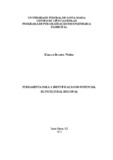| dc.creator | Weiler, Elenice Broetto | |
| dc.date.accessioned | 2021-11-04T13:57:59Z | |
| dc.date.available | 2021-11-04T13:57:59Z | |
| dc.date.issued | 2021-05-31 | |
| dc.identifier.uri | http://repositorio.ufsm.br/handle/1/22709 | |
| dc.description.abstract | The demand for wood and products from planted forests will increase given the prospect of population growth. Thus, the expected need to increase areas with forest plantations for the next decades, in line with the development of the regions, is a fundamental topic of debate. Would the Rio Grande Sul have potential territory for production? Is the State prepared for this market? Could small rural properties be part of this future scenario? Could new investments add to regional development? The main focus of the thesis was the verification of the silvicultural potential in terms of spatial distribution in the northern Rio Grande do Sul, with a case study in Corede Celeiro. The proposal to create a Normalized Silvicultural Index categorized 21 municipalities into classes with different potentials for planting (Excellent, Very Good, Good, Low, and Inapt). The municipalities were characterized to understand the dynamics related to socioeconomic and human development, by verifying areas cultivated with forestry, through the quantification and mapping of forest plantations. Also, the lack of a pattern of plantations distribution was verifyed, from the relationship with the geomorphological characterization and the proposal of a normalized linear model based on multivariate information of physical, social and economic aspects. Thus, it was possible to georeference, spatialize and integrate information, promoting the territory recognition, with an understanding of which factors and what weight each has on the municipal scale, reflecting in the categorization of a silvicultural potential. In this way, the results of this thesis will serve as a tool for public authorities to include planted forests in sustainable development plans, as well for planning silvicultural activities, as the private sector, in line with the specificities of the environment. The proposal is also in line with new methodological possibilities that may contribute to adapting to changes in territorial planning, licensing, and development projects for silvicultural activities. | eng |
| dc.description.sponsorship | Coordenação de Aperfeiçoamento de Pessoal de Nível Superior - CAPES | por |
| dc.language | por | por |
| dc.publisher | Universidade Federal de Santa Maria | por |
| dc.rights | Attribution-NonCommercial-NoDerivatives 4.0 International | * |
| dc.rights.uri | http://creativecommons.org/licenses/by-nc-nd/4.0/ | * |
| dc.subject | Modelagem silvicultural | por |
| dc.subject | Plantios florestais | por |
| dc.subject | Desenvolvimento regional | por |
| dc.subject | Silvicultural modeling | eng |
| dc.subject | Forest plantations | eng |
| dc.subject | Regional development | eng |
| dc.title | Ferramenta para a identificação do potencial silvicultural regional | por |
| dc.title.alternative | Tool for identification of regional silvicultural potential | eng |
| dc.type | Tese | por |
| dc.description.resumo | A demanda por madeira e produtos oriundos de florestas plantadas deverá aumentar diante da perspectiva de crescimento populacional. Com isso, a necessidade projetada de aumento de áreas com plantios florestais para as próximas décadas, em consonância ao desenvolvimento de regiões, é tema fundamental de debate. Teria o território Rio-Grandense potencial em termos espaciais para produção? O Estado está preparado para este mercado? Pequenas propriedades rurais poderão fazer parte deste cenário futuro? Novos investimentos poderão agregar ao desenvolvimento regional? Diante dessas indagações, a principal preocupação da tese foi a verificação do potencial silvicultural em termos de distribuição espacial no norte gaúcho, com estudo de caso no Corede Celeiro. A proposta de criação de um Índice Silvicultural Normalizado categorizou 21 municípios em classes com diferentes potenciais para plantios (Excelente, Muito Bom, Bom, Baixo e Inapto). Fez-se a caracterização dos municípios no intuito de entender a dinâmica referente ao desenvolvimento socioeconômico e humano, pela verificação de áreas cultivadas com silvicultura, por meio da quantificação e mapeamento de plantios florestais. Buscou-se também verificar a inexistência de um padrão de distribuição dos plantios florestais, a partir da relação com a caracterização geomorfológica e da proposta de um modelo linear normalizado com base em informações multivariadas de aspectos físicos, sociais e econômicos. Com isso, foi possível georreferenciar, espacializar e integrar informações, promovendo o reconhecimento do território, com entendimento de quais fatores e que peso cada um possui na escala municipal, refletindo na categorização de um potencial silvicultural. Dessa maneira, a tese servirá como ferramenta para autoridades públicas incluírem florestas plantadas nos planos de desenvolvimento sustentável, bem como no planejamento, pelo setor privado, das atividades silviculturais em consonância com as especificidades do ambiente. A proposta também está alinhada a novas possibilidades metodológicas que venham a contribuir para adaptação às mudanças no planejamento territorial, licenciamentos e projetos de fomento para atividades silviculturais. | por |
| dc.contributor.advisor1 | Reichert, José Miguel | |
| dc.contributor.advisor1Lattes | http://lattes.cnpq.br/0910765178697312 | por |
| dc.contributor.advisor-co1 | Cruz, Jussara Cabral | |
| dc.contributor.advisor-co1Lattes | http://lattes.cnpq.br/3525141443261254 | por |
| dc.contributor.referee1 | Farias, Jorge Antonio de | |
| dc.contributor.referee2 | Silva, Emanuel Araújo | |
| dc.contributor.referee3 | Panno, Fernando | |
| dc.contributor.referee4 | Fernandes, Sandra Beatriz Vicenci | |
| dc.creator.Lattes | http://lattes.cnpq.br/4697949415220109 | por |
| dc.publisher.country | Brasil | por |
| dc.publisher.department | Recursos Florestais e Engenharia Florestal | por |
| dc.publisher.initials | UFSM | por |
| dc.publisher.program | Programa de Pós-Graduação em Engenharia Florestal | por |
| dc.subject.cnpq | CNPQ::CIENCIAS AGRARIAS::RECURSOS FLORESTAIS E ENGENHARIA FLORESTAL | por |
| dc.publisher.unidade | Centro de Ciências Rurais | por |



